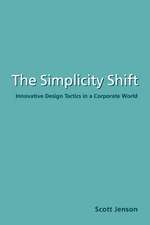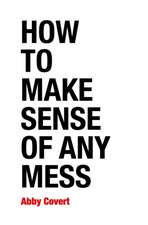Designing with the Mind in Mind: Simple Guide to Understanding User Interface Design Guidelines
Autor Jeff Johnsonen Limba Engleză Paperback – 19 noi 2020
- Provides an essential source for user interface design rules and how, when, and why to apply them
- Arms designers with the science behind each design rule, allowing them to make informed decisions in projects, and to explain those decisions to others
- Equips readers with the knowledge to make educated tradeoffs between competing rules, project deadlines, and budget pressures
- Completely updated and revised, including additional coverage in such areas as persuasion, cognitive economics and decision making, emotions, trust, habit formation, and speech UIs
Preț: 244.58 lei
Preț vechi: 372.27 lei
-34% Nou
46.81€ • 48.69$ • 38.64£
Carte disponibilă
Livrare economică 17-31 martie
Livrare express 08-14 martie pentru 90.76 lei
Specificații
ISBN-10: 0128182024
Pagini: 304
Ilustrații: Approx. 175 illustrations (175 in full color)
Dimensiuni: 191 x 235 x 18 mm
Greutate: 0.63 kg
Ediția:3
Editura: ELSEVIER SCIENCE
Public țintă
Students and teachers in computer science, graphic design, HCI, and usability; Interface designers and developers, software designers, web designers, web application designers, interaction designers, usability engineers, usability evaluators and development managersCuprins
1. Our Perception is Biased 2. Our Vision is Optimized to See Structure 3. We Seek and Use Visual Structure 4. Our Color Vision is Limited 5. Our Peripheral Vision is Poor 6. Reading is Unnatural 7. Our Attention is Limited; Our Memory is Imperfect 8. Limits on Attention Shape Our Thought and Action 9. Recognition is Easy; Recall is Hard 10. Learning from Experience and Performing Learned Actions are Easy; Problem Solving and Calculation are Hard 11. Many Factors Affect Learning 12. Human Decision-Making is Rarely Rational 13. Our Hand-Eye Coordination Follows Laws 14. We Have Time Requirements
Descriere
User interface (UI) design rules and guidelines, developed by early HCI gurus and recognized throughout the field, were based on cognitive psychology (study of mental processes such as problem solving, memory, and language), and early practitioners were well informed of its tenets. But today practitioners with backgrounds in cognitive psychology are a minority, as user interface designers and developers enter the field from a wide array of disciplines. HCI practitioners today have enough experience in UI design that they have been exposed to UI design rules, but it is essential that they understand the psychological basis behind the rules in order to effectively apply them. In Designing with the Mind in Mind, best-selling author Jeff Johnson provides designers with just enough background in perceptual and cognitive psychology that UI design guidelines make intuitive sense rather than being just a list of rules to follow.
- Provides an essential source for user interface design rules and how, when, and why to apply them
- Arms designers with the science behind each design rule, allowing them to make informed decisions in projects, and to explain those decisions to others
- Equips readers with the knowledge to make educated tradeoffs between competing rules, project deadlines, and budget pressures
- Completely updated and revised, including additional coverage in such areas as persuasion, cognitive economics and decision making, emotions, trust, habit formation, and speech UIs

















